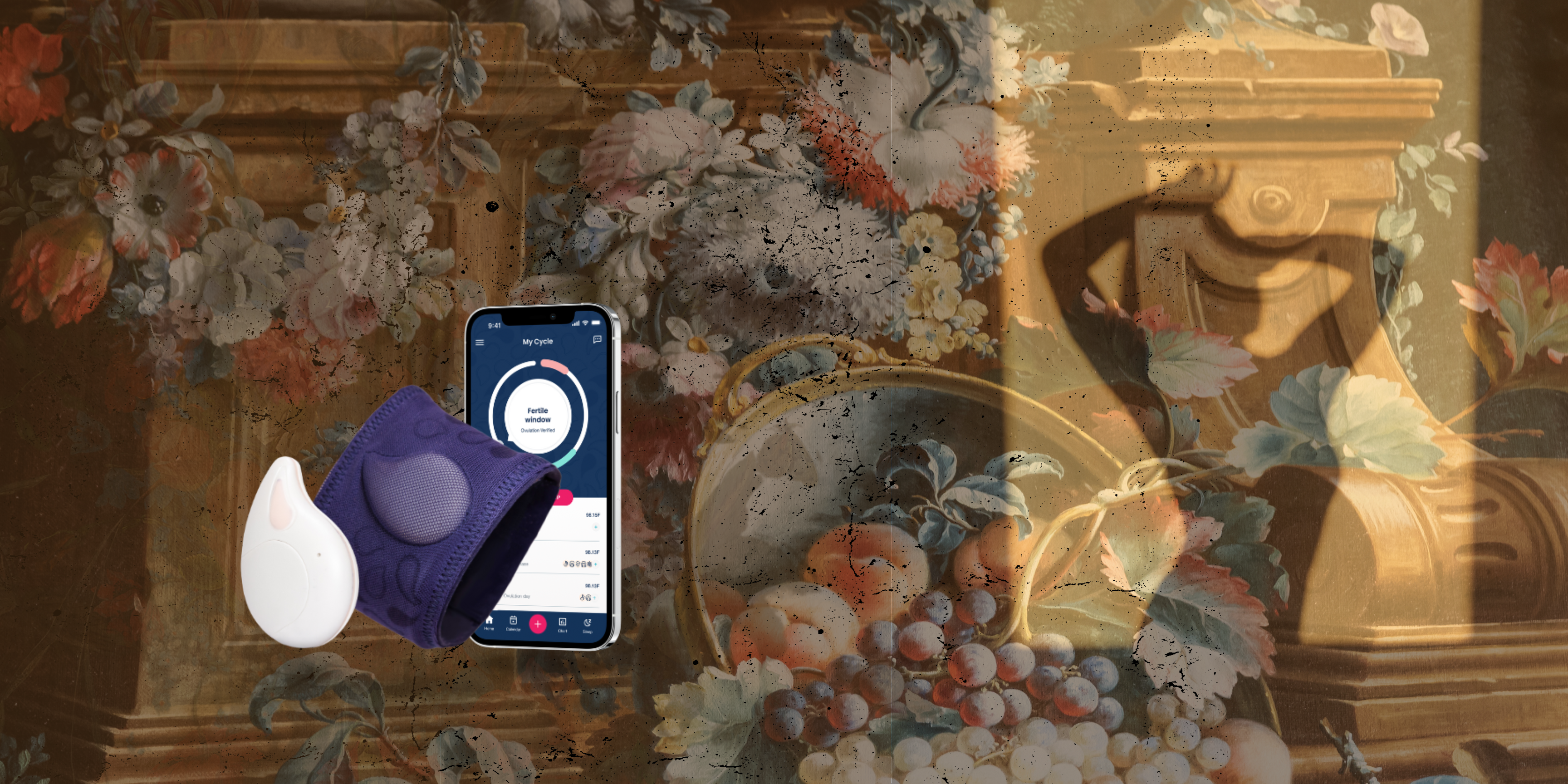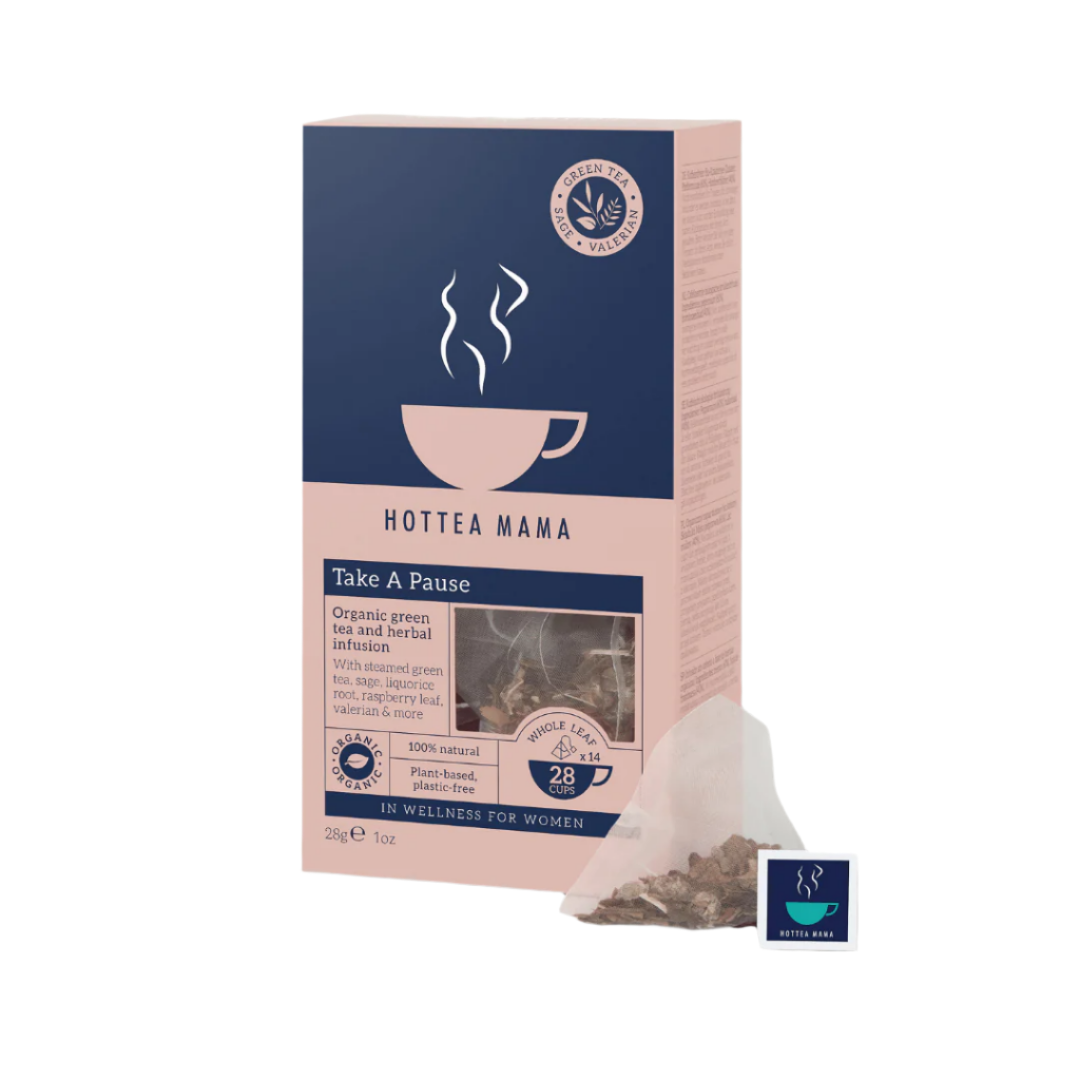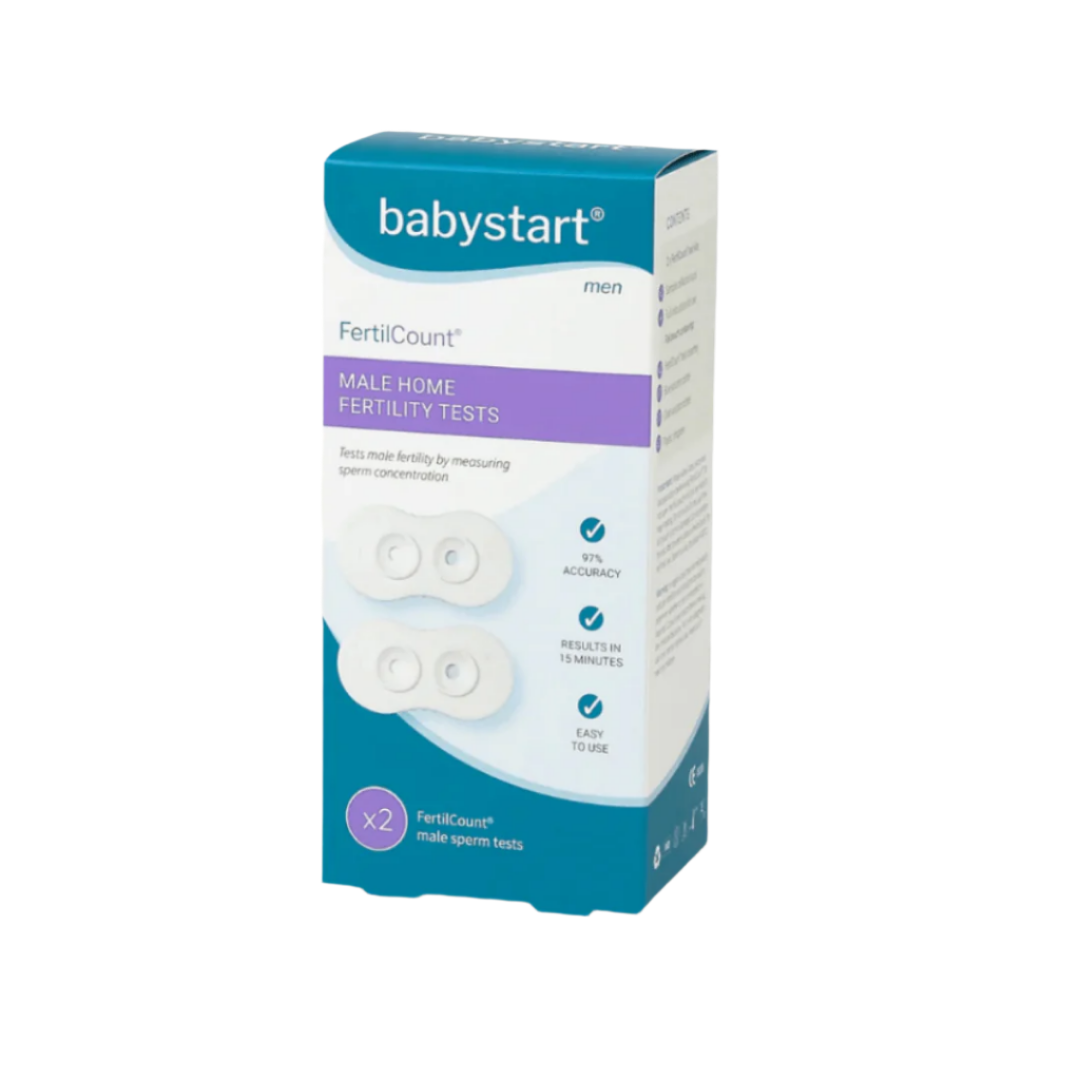




Fertility Monitoring
Tempdrop to monitor your fertility. Track your cycle whilst you sleep, understand your fertility window better
Tempdrop Fertility Monitor | Version 2
Tempdrop Fertility Monitor | Version 2
Tempdrop brings the full fertility tracking solution to your smartphone. Whether you are looking to increase your chances of conceiving, or are practicing fertility awareness methods, Tempdrop is tailored to you.
Sizing:
S/M fits 8.5"-15.5"/21.5cm - 39cm.
L/XL fits 12.5"-18.5" /31.5cm- 47cm.
Please measure your arm in advance of placing your order
Please note: Orders shipped to Ireland femme will pay the customs charges.
83 in stock
Share this product
How It Works
Fertility & ovulation tracking
Introducing Tempdrop - a wearable fertility monitor.
Tempdrop sensor & app: A lifelong companion.
Tempdrop Replacement Armbands | Version 2
Tempdrop Replacement Armbands | Version 2
Upgrade your Tempdrop experience with our comfortable and durable replacement bands. Designed with your convenience in mind, these bands ensure a perfect fit for every user while maintaining the seamless functionality of your Tempdrop device.
Key Features:
- Custom Fit: Adjustable straps to accommodate all arm sizes for a secure and comfortable fit throughout the night.
- Premium Materials: Soft, hypoallergenic fabric that’s gentle on the skin and built to withstand daily use.
- Easy Installation: Replace your old band in seconds with our hassle-free design.
- Breathable Design: Enhanced airflow ensures all-night comfort, even for sensitive skin types.
- Stylish and Versatile: Available in neutral tones to complement your Tempdrop device.
Whether you need a spare or a replacement, these bands are the perfect accessory to keep your Tempdrop functioning at its best. Stay consistent with your tracking without missing a beat.
Compatibility:
Exclusively designed for use with the Tempdrop wearable thermometer.
Keep your Tempdrop secure and comfortable with our high-quality replacement bands—because your wellness journey deserves the best.
Hurry up, only 10 items left in stock.
Share this product
Ovulation tracking: Four Easy Steps
Step One: Wear before sleep
Before you go to sleep, press the drop-shaped button to turn on your Tempdrop sensor. Place the band on your upper arm and leave it on throughout the night.
Step Two: Sync whenever
Remove once you are up for the day and sync with the Tempdrop app whenever convenient.
Step Three: Add your symptoms
Track your symptoms to verify ovulation and learn about your cycle phases.
Step Four: Get results
View the chart and interpret your results. Upgrade to premium for automatic interpretation.

Recently on The femme Journal
We are here to help you with every stage of your fertility journey. Some of our recent blog posts may interest you.
Using Cycle Tracking to Manage Conditions like PCOS and Endometriosis
For many people, reproductive health conditions like polycystic ovary syndrome (PCOS) and endometriosis don’t just affect fertility—they impact daily life. From unpredictable cycles to painful symptoms, these conditions can feel like they’re running the show. That’s why using cycle tracking to manage conditions like PCOS and endometriosis is such a powerful tool. It’s not just about fertility awareness. It’s about gaining knowledge, spotting patterns, and having real data you can use to take back some control. And with Tempdrop, the process becomes simpler, more accurate, and more reliable than traditional methods. Why using cycle tracking to manage conditions like PCOS and endometriosis matters Both PCOS and endometriosis can make cycles irregular, painful, or difficult to understand. Doctors often say “keep a cycle diary” — but when your periods don’t follow a predictable pattern, that advice can feel frustrating. By using cycle tracking to manage conditions like PCOS and endometriosis , you get more than just a diary. You get: Insight into whether ovulation is happening Data on how long your cycles really are Patterns between hormone shifts and symptom flare-ups A clearer way to advocate for yourself with healthcare providers This kind of information can make all the difference in day-to-day management and long-term treatment plans. How Tempdrop Makes Cycle Tracking Easier Traditional basal body temperature (BBT) tracking requires you to wake up at the same time every morning, take your temperature, and log it. For people with disrupted sleep or unpredictable schedules, this is nearly impossible. Tempdrop changes the game. You wear it on your arm overnight, and it automatically records your temperature while you sleep. The app filters out “noise” from restless nights and gives you a reliable chart of your cycle. For anyone using cycle tracking to manage conditions like PCOS and endometriosis , this means: Less stress and fewer missed readings Accurate confirmation of ovulation (when it happens) Data you can actually trust, even with irregular cycles Managing PCOS with Cycle Tracking Polycystic ovary syndrome is one of the most common causes of irregular ovulation. Some cycles may be anovulatory, while others are delayed or unpredictable. This can make it hard to know when (or if) you’re fertile and to understand how your body is working. By using cycle tracking to manage conditions like PCOS and endometriosis , you can: Confirm whether ovulation is occurring in a given cycle Track how long your luteal phase lasts when ovulation happens Identify trends that might otherwise be invisible (like recurring long cycles) With Tempdrop, you don’t have to guess whether a bleed is a true period or just breakthrough bleeding. Temperature data helps you see whether ovulation actually occurred. That clarity is invaluable for anyone navigating PCOS. Managing Endometriosis with Cycle Tracking Endometriosis isn’t just about painful periods—it often brings fatigue, digestive issues, and inflammation that can flare at different points in the cycle. Without tracking, it can feel random and overwhelming. By using cycle tracking to manage conditions like PCOS and endometriosis , you can start connecting symptoms with hormonal phases. For example: Pain flares may intensify during the luteal phase Fatigue may peak around ovulation Digestive changes may line up with menstrual bleeding Tempdrop helps confirm where you are in your cycle, so you can connect your lived experience with real hormonal shifts. That awareness makes it easier to prepare, adjust routines, and advocate for better support. Turn Data into Advocacy Healthcare appointments for PCOS or endometriosis are often short, and it can be hard to explain the complexity of your symptoms in a 10-minute slot. By using cycle tracking to manage conditions like PCOS and endometriosis , you bring evidence. With Tempdrop data, you can show your doctor: How often ovulation is (or isn’t) happening Cycle lengths across several months Symptom patterns tied to hormonal changes This makes conversations more productive and can speed up diagnosis, treatment, or referrals. Emotional Benefits of Tracking Living with PCOS or endometriosis can feel unpredictable and sometimes isolating. One of the overlooked benefits of using cycle tracking to manage conditions like PCOS and endometriosis is the emotional reassurance it provides. Instead of feeling like your body is working against you, you begin to see patterns and explanations. That knowledge doesn’t erase the challenges, but it can reduce anxiety and increase confidence. With Tempdrop, the process feels less like a chore and more like a supportive routine. Practical Tips for Getting Started If you’re considering using cycle tracking to manage conditions like PCOS and endometriosis, here are some tips: Be consistent – Wear your Tempdrop every night for the best results. Log symptoms – Use the app notes to connect physical changes with cycle phases. Be patient – Irregular cycles may take months to reveal useful patterns. Combine tools – Track cervical mucus, bleeding, and lifestyle factors alongside Tempdrop data. Share results – Bring your charts to appointments to strengthen conversations with healthcare professionals. The Bottom Line Conditions like PCOS and endometriosis can make cycles feel like a mystery. But by using cycle tracking to manage conditions like PCOS and endometriosis , you gain insight, clarity, and confidence. With Tempdrop, the process becomes easier and more reliable, even if your cycles are irregular or symptoms unpredictable. It’s not just about fertility—it’s about understanding your body, improving communication with doctors, and making empowered decisions about your health. Because when it comes to chronic conditions, knowledge really is power—and Tempdrop helps put that power back in your hands. Laura Cartwright Laura Cartwright is one of the founders of femme health. Having worked in the diagnostics industry for over 15 years, Laura is passionate about improving women's health, to create an equitable and forward-thinking landscape which proactively supports health outcomes. Learn more
Learn moreTracking Your Cycle During Perimenopause with Tempdrop
Perimenopause is often described as the “in-between” stage: not quite menopause, but not your usual monthly rhythm either. Hormones fluctuate, cycles become less predictable, and symptoms can feel confusing. For many women, this stage starts in their 40s, but it can arrive earlier. The challenge is that while your body is changing, it’s not always easy to make sense of what’s happening. This is where tracking your cycle during perimenopause becomes incredibly useful. Instead of relying on guesswork, you can gather real insights into how your body is shifting. And with the help of Tempdrop, you can make sense of irregular cycles, spot ovulation when it still happens, and feel more in control of this life transition. Why Tracking your Cycle During Perimenopause Matters Perimenopause isn’t a straight line. One month you might ovulate as usual, and the next your period may be late, early, or missing altogether. For some, hot flushes, mood changes, and sleep problems appear long before cycles stop completely. By tracking your cycle during perimenopause , you get answers to important questions like: Am I still ovulating? How long are my cycles now? Are my symptoms connected to hormone changes? Is there a pattern to the unpredictability? This isn’t just about fertility—it’s about knowledge. The better you understand your changing cycle, the easier it is to make informed choices about your health, wellbeing, and daily life. How Tempdrop Supports Tracking your Cycle During Perimenopause Traditional basal body temperature (BBT) tracking can be difficult at this stage of life. Waking up at the same time every day to take your temperature is tough enough without night sweats, disturbed sleep, or busy mornings. Tempdrop offers a more practical solution. You wear it on your arm overnight, and it automatically records your temperature while you sleep. The app smooths out any irregularities caused by restlessness or inconsistent sleep schedules, giving you reliable data without extra effort. For women who are tracking your cycle during perimenopause , Tempdrop can highlight: Whether ovulation is still occurring in some cycles How long the luteal phase lasts Shifts in cycle length over time Connections between symptoms and hormonal changes Spotting Ovulation When Cycles are Irregular One of the most confusing parts of perimenopause is not knowing if or when ovulation is happening. Some cycles are anovulatory (meaning no egg is released), while others are normal. By tracking your cycle during perimenopause with Tempdrop, you can see the subtle rise in temperature that signals ovulation. This gives you clarity—whether you’re curious about fertility, wondering if contraception is still necessary, or just wanting to understand what your hormones are doing. Even when ovulation becomes less frequent, knowing when it does occur helps you make sense of your symptoms and plan around your cycle more effectively. Connecting Symptoms to Hormone Changes Many perimenopausal symptoms—such as mood swings, anxiety, hot flushes, or fatigue—are linked to fluctuating hormones. But when those symptoms appear randomly, it can feel unsettling. By tracking your cycle during perimenopause , you can start to connect the dots. Maybe night sweats are worse in the luteal phase, or mood changes peak just before your period. Tempdrop provides objective data, so you’re not left wondering whether these experiences are random or hormone-driven. This knowledge can also be incredibly helpful if you decide to speak with a healthcare professional. Bringing cycle data and symptom patterns to an appointment makes it easier to have a productive conversation about treatment options, whether that’s HRT, lifestyle changes, or other support. Emotional Reassurance in a Time of Change Perimenopause can feel like losing control over your own body. Cycles that were once predictable may now come with uncertainty, and the physical changes can affect confidence and self-esteem. Tracking your cycle during perimenopause doesn’t fix everything, but it can help you feel grounded. Instead of being blindsided by irregular periods or unpredictable moods, you’ll have a clearer sense of what’s happening and why. For many women, that reassurance is powerful. It shifts the perspective from “my body is failing me” to “my body is changing, and I understand how.” Practical Tips for Tracking your Cycle During Perimenopause If you’re ready to start tracking your cycle during perimenopause with Tempdrop, here are a few simple tips: Be consistent – Wear your Tempdrop nightly for the most accurate picture. Log symptoms – Use the notes feature to connect temperature data with real-life experiences like sleep changes or mood shifts. Combine signs – Cervical mucus and cycle length still matter, even in perimenopause. Together with Tempdrop, they give a fuller picture. Be patient – Patterns may take time to emerge, especially if cycles are irregular. Share your data – If you talk to your GP or a menopause specialist, Tempdrop charts can make the conversation easier. The Bigger Picture While fertility may no longer be your focus, tracking your cycle during perimenopause is still an empowering practice. It helps you recognise the changes your body is going through, anticipate symptoms, and approach this transition with knowledge rather than uncertainty. Tempdrop makes this process simple, even when sleep and schedules aren’t. It’s less about perfect data and more about giving yourself insight, compassion, and confidence during a stage of life that can otherwise feel overwhelming. The Bottom Line Perimenopause is unpredictable, but it doesn’t have to leave you in the dark. By tracking your cycle during perimenopause with Tempdrop, you can understand what’s happening in your body, connect symptoms to hormonal shifts, and navigate this stage with more clarity. This isn’t about controlling perimenopause—it’s about making peace with it. And having tools that support you, rather than add stress, can make all the difference. Laura Cartwright Laura Cartwright is one of the founders of femme health. Having worked in the diagnostics industry for over 15 years, Laura is passionate about improving women's health, to create an equitable and forward-thinking landscape which proactively supports health outcomes. Learn more
Learn moreUsing Tempdrop When You’re Trying to Conceive
When you’re trying to conceive , you expect it to take a few months. But when those months stretch into a year—or even longer—it can feel like a mix of frustration, self-doubt, and endless questions. In the UK, you usually need to wait two years before being referred for fertility investigations if you’re under 35. That’s a long time to feel in the dark about what’s happening in your body. This is where cycle tracking tools like Tempdrop come in. They don’t promise instant results or magic fixes, but they give you something equally important: clarity. By helping you confirm ovulation, understand your cycle, and recognise your fertile window, Tempdrop can make the difficult process of trying to conceive a little less overwhelming. Why cycle tracking matters when you're trying to conceive Most people are told the basics: have unprotected sex regularly when you're trying to conceive and you’ll get pregnant within a year. For many, that’s true. But when it doesn’t happen, it’s natural to start wondering: Am I ovulating? Are my cycles regular? Is there something I’m missing? That’s why cycle tracking is so valuable when you’re trying to conceive. It doesn’t just help you know when to have sex; it also gives you reassurance that your body is doing what it’s supposed to do, or early clues if it’s not. With a tool like Tempdrop, you can: Confirm that ovulation is happening each month Identify your actual fertile window (not just the textbook version) Notice irregularities that might be worth mentioning to your doctor later Feel more in control during the waiting period The Challenge of the Two-Year Wait In the UK, if you’re under 35, you’re usually advised to keep trying to conceive naturally for two years before getting a referral for fertility testing. For those over 35, the timeframe is shorter (usually 12 months). But either way, it can feel like a long time to wait when month after month goes by without a positive test. During this time, cycle tracking with Tempdrop can give you peace of mind. You’ll know whether ovulation is happening regularly, and if it’s not, you’ll have reliable data to bring to your GP sooner rather than later. Even if everything looks normal, Tempdrop offers reassurance when you're trying to conceive: you’re not “missing” your fertile days, and you’re giving yourself the best chance possible. How Tempdrop Works for People Trying to Conceive Traditional basal body temperature (BBT) tracking can be tricky when you're trying to conceive. You’re supposed to take your temperature every morning at the same time, before getting out of bed, and log it manually. That’s tough if you’re working shifts, travelling, or just want a lie-in. Tempdrop makes it easier. You wear it on your arm overnight, and it automatically records your temperature while you sleep. The app smooths out any variations caused by restless nights or inconsistent wake-up times, giving you a clear chart of your cycle. For people trying to conceive , that means: No stressful morning routines Reliable confirmation of ovulation A bigger, clearer picture of how your cycles are working Tracking Ovulation with Tempdrop When Trying to Conceive When ovulation occurs, progesterone rises and your body temperature shifts slightly. Tempdrop picks up this change, showing you whether ovulation happened and when. This is crucial when you’re trying to conceive , because it confirms whether you’ve actually had a fertile cycle. Over time, you’ll start to see patterns: How long your luteal phase (time between ovulation and your next period) lasts Whether your cycles are consistent or irregular Which days of the month you’re most fertile This kind of knowledge can make all the difference in how you approach trying to conceive . What if You're Not Ovulating Regularly One of the most stressful parts of trying to conceive is not knowing whether there’s a problem. With Tempdrop , you can spot if ovulation isn’t happening regularly—or at all. That doesn’t mean you won’t get pregnant naturally, but it’s useful information for your own peace of mind. And if you do eventually reach the point where you’re referred for fertility support, having months (or years) of tracked cycles can help your doctor understand your situation faster. Instead of starting from scratch, you’ll already have valuable data to share. Emotional Support while Trying to Conceive Let’s be honest: the emotional side of trying to conceive is often harder than the physical side. Each month can feel like a cycle of hope, disappointment, and pressure. Having tools like Tempdrop doesn’t erase those feelings, but it can give you back a sense of agency. By knowing what your body is doing, you avoid the endless “what ifs.” You can feel confident that you’re identifying your fertile window accurately, even if it takes time to see that positive test. Practical Tips for using Tempdrop While Trying to Conceive Be consistent – Wear your Tempdrop every night for the most reliable data. Track other signs too – Cervical mucus and cycle length are useful alongside your temperature data. Be patient – It may take a few months of data before patterns emerge. Share your charts if needed – If you eventually see a doctor, your Tempdrop records can provide a helpful starting point. The Bottom Line If you’re in the early months of trying to conceive —or even if you’re approaching the two-year wait for fertility support—using a tool like Tempdrop can help you feel less powerless. It won’t guarantee pregnancy, but it will give you the knowledge, reassurance, and confidence that you’re doing everything you can during this chapter. And sometimes, that clarity is exactly what you need to keep going. Because when it comes to fertility, knowledge really is power—and Tempdrop gives you exactly that. Laura Cartwright Laura Cartwright is one of the founders of femme health. Having worked in the diagnostics industry for over 15 years, Laura is passionate about improving women's health, to create an equitable and forward-thinking landscape which proactively supports health outcomes. Learn more
Learn moreCycle Tracking After the Pill: How to Understand Your Body Again
Coming off the pill is exciting, but it can also feel a little overwhelming. After years of your cycle being managed by hormones, you might be asking: When will my natural cycle return? How will I know if I’m ovulating? And what if I want to try for a baby soon? That’s where cycle tracking after the pill comes in. Understanding what’s happening in your body gives you clarity, reassurance, and confidence. And with the help of smart tools like Tempdrop , you can spot when ovulation returns and build a clear picture of your fertility—without the stress. Let’s break down what to expect after stopping the pill, why cycle tracking matters, and how to use Tempdrop to get reliable insights. What happens to your cycle after stopping the pill? The pill works by stopping ovulation. When you stop taking it, your body needs time to find its natural rhythm again. For some people, ovulation returns immediately. For others, it can take months. Common experiences include: Irregular or unpredictable cycles Lighter or heavier bleeding than expected PMS or cramps that feel stronger than you remember Not knowing whether or not you’ve actually ovulated This is exactly why cycle tracking after the pill is so helpful. Instead of guessing, you can see what’s really happening. Why Cycle Tracking After the Pill is so Valuable Whether or not you’re ready to conceive right away, cycle tracking after the pill gives you important information: Confirming ovulation – You’ll know whether your cycles are fertile again. Spotting irregularities – If ovulation is delayed or cycles are very long, you’ll notice it early. Reducing stress – No more second-guessing whether your period is “normal” or not. Planning ahead – When you’re ready to try for pregnancy, you’ll already understand your fertile window. And while you can track things like cervical mucus and cycle length, temperature is one of the most reliable signs of ovulation. That’s where Tempdrop comes in. How Tempdrop Makes Cycle Tracking Easier Traditional basal body temperature (BBT) tracking means waking up at the same time every morning, before moving, to take your temperature. Not exactly practical if you like sleep-ins, work shifts, or travel a lot. Tempdrop solves that problem. You wear it on your arm overnight, and it automatically records your temperature while you sleep. The app smooths out any “noisy” data and gives you a reliable chart of your cycle. For cycle tracking after the pill , this is a huge advantage. Even if your cycles are irregular or unpredictable, Tempdrop can still pick up when ovulation finally happens. Spotting ovulation with Tempdrop When ovulation occurs, progesterone rises—and with it, your body temperature increases slightly. When you start cycle tracking after the pill, Tempdrop identifies this subtle shift so you can see: If and when ovulation has taken place How long your luteal phase (the time between ovulation and your next period) lasts Whether your cycle is returning to a regular rhythm This is especially useful after coming off the pill, when you might not recognise your body’s other fertility signs right away. Building your Fertility Awareness Using Tempdrop for cycle tracking after the pill gives you a strong foundation, but it’s even more powerful when you combine it with other signs: Cervical mucus changes – Often the first signal that ovulation is approaching Cycle length – Logging start and end dates helps you spot trends over time Lifestyle notes – Stress, illness, and travel can all affect your cycle; tracking these factors alongside your data makes patterns clearer The more cycles you track, the clearer your personal fertility pattern becomes. Why This Matters if you're Thinking About Pregnancy You might not be ready to try for a baby tomorrow—but if kids are in your near future, cycle tracking after the pill puts you in control. If your cycles return quickly, Tempdrop confirms that you’re ovulating regularly. If your cycles are irregular, you’ll still know when your fertile window is happening. If ovulation isn’t showing up at all, you’ll have solid data to share with your doctor, saving time down the line. Rather than waiting and wondering, cycle tracking after the pill will help you have a clear picture of where your body is at. Common Worries (and How Tempdrop Can Help) Many people worry when their cycles don’t settle straight away. Here’s what’s normal: It can take months for ovulation to return after the pill. Tempdrop reassures you by showing small changes, even if cycles aren’t perfect yet. Cycles don’t have to be textbook, especially when you start cycle tracking after the pill. Ovulation can still happen in a 35-day cycle. Tempdrop helps confirm it, so you’re not left guessing. Professional support is available. If you’ve been cycle tracking after the pill for 6–12 months without signs of ovulation, you’ll already have detailed information to share with a healthcare professional. Be Kind to Yourself Coming off the pill and starting to think about pregnancy is a big moment. It’s easy to feel frustrated if your body doesn’t bounce back instantly. But remember: irregular cycles are normal at first, and patience really is part of the process. With Tempdrop and consistent cycle tracking after the pill, you don’t have to sit in the dark wondering. You’ll see progress, recognise patterns, and know your body better than ever before. The Bottom Line about Cycle Tracking after the Pill If you’ve just come off the pill and want to prepare for pregnancy in the near future, cycle tracking after the pill is one of the smartest steps you can take. And with Tempdrop , it’s easier, more accurate, and way less stressful than old-school BBT tracking. You’ll know if and when you’re ovulating, understand your fertile window, and have reliable data whether your cycles are regular, irregular, or still finding their rhythm. Because when it comes to fertility, knowledge really is power—and Tempdrop gives you exactly that. Laura Cartwright Laura Cartwright is one of the founders of femme health. Having worked in the diagnostics industry for over 15 years, Laura is passionate about improving women's health, to create an equitable and forward-thinking landscape which proactively supports health outcomes. Learn more
Learn more


























